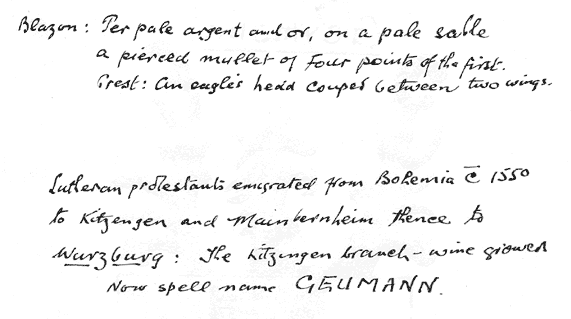| GEYMANN (compiled by George Gustav)
Rudolf I of Habsburg made a Grant of Arms (burgher arms) i.e.
arms common to family or tribe which are not modified for
personal use but remain, constant through succeeding generations.
Granted in late 13th century, details in Paul Furstschen's
Book of Heraldry page XVIl, in Munich Archives.
Blazon -- per pale, argent and or, a pale sable charged with a
rowel of four points, argent, in fesse.
In the early years of the sixteenth century the scandals of
the sale of indulgences, the concubinage in the church and
the inquisition, and the spread of the printing press, gave
Martin Luther and the Reformation enormous impetus. While the
Diet of Augsburg in 1555 was hesitating in granting religious
peace, a rival assembly of more princes than were at the Diet
met at Naumberg and decided to adhere to the ‘Confession of
Augsburg' . This principle was—’Cuius regio, eius religio;’
each prince might choose for himself between Catholicism and
Protestantism; his subjects must submit to that choice unless
they preferred to emigrate.
The protestant Geymann tribe then emigrated from Bohemia and
settled in Kitzingen and Mainbernheim. The farmers and wine—
growers remaining in that area, distant cousins, now spell
their name-GEUMANN. The direct ancesters settled in Wurzburg.
Georg Geymann was born there in 1836 and became a minor
post office official. He married Anna Marganita ? in 1873.
She was a Lutheran deaconess; she nursed soldiers during the
Franco-Prussian War during the course of which she contracted
typhus and had to leave the order. After their marriage
they transferred to Frankfurt-am-Main where Georg Gustav was
born in 1874 and Anna in 1875. Anna married a shipping merchant
lived at Strasburg and Basal and then back at Wurzburg, where
her son Heinrich was Town Clerk. He died in a Russian prison
camp in 1945. Her daughter. Mali (Molly) emigrated to America
in 1923. Gustav served an apprenticeship as a hairdresser and
left Bavaria about 1895, travelled around Europe and finally
settled in London for good wnen he married Agnes Bridger in1905
Gustave born 1906, died 1907. George Gustave born 1907, and
Rita Agnes born 1908, married 1934 Maureen born 1936 The three
were killed by enemy action at Hull in 1942.
|

